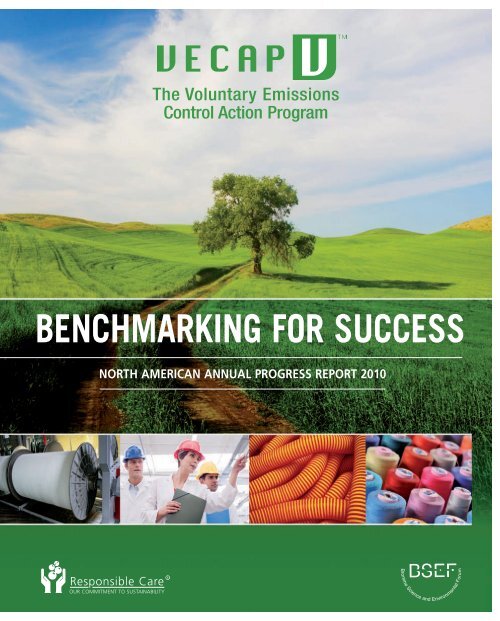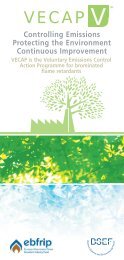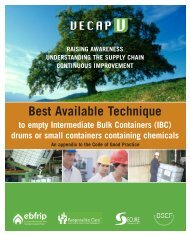Annual Progress Report 2010 - VECAP
Annual Progress Report 2010 - VECAP
Annual Progress Report 2010 - VECAP
- No tags were found...
You also want an ePaper? Increase the reach of your titles
YUMPU automatically turns print PDFs into web optimized ePapers that Google loves.
CONTENTS02 HIGHLIGHTS03 RESPONSIBLE CARE® AND <strong>VECAP</strong>04 I. INTRODUCTION TO <strong>VECAP</strong>04 Background and evolution05 How does <strong>VECAP</strong> work?05 <strong>VECAP</strong> certification05 The <strong>VECAP</strong> team and emissions survey tool06 Emissions data collection and reporting06 Providing support to <strong>VECAP</strong> users08 II. <strong>VECAP</strong> PROGRESS REPORT <strong>2010</strong>08 Overview of the <strong>2010</strong> survey08 Key finding10 Deca-BDE12 HBCD14 TBBPA16 III. OUR VISION FOR THE FUTUREThe Voluntary Emissions Control Action ProgramNorth American <strong>Annual</strong> <strong>Progress</strong> <strong>Report</strong> <strong>2010</strong> 1
I. INTRODUCTION TO <strong>VECAP</strong>The Voluntary Emissions Control Action Program (<strong>VECAP</strong>) is an innovative and excellence-driven way ofmanaging chemicals. It demonstrates the proactive involvement of companies committed to acting in thebest interests of society and the environment. <strong>VECAP</strong> aims to reduce emissions of polymer additivesthrough the promotion of environmental and process best practices throughout the value chain, fromproducers to downstream users.In North America, <strong>VECAP</strong> aspires to set newstandards for chemicals management in theworkplace, both at manufacturing sites andwithin the value chain. It offers all companies– small, medium and large – equal accessto industry expertise in environmental bestpractices, while setting benchmarks for otherindustries to apply similar principles. <strong>VECAP</strong>represents a voluntary and proactive effortto reduce emissions to the environment thatexceeds present North American regulatorystandards. <strong>VECAP</strong> is now implemented in allmanufacturing plants for Deca-BDE, HBCDand TBBPA by the three main producers offlame retardants globally.The <strong>VECAP</strong> program focuses on both producersand downstream users of flame retardants.However, in principle, the <strong>VECAP</strong> methodologycan be applied to encourage emissions reductionsof any type of solid or liquid chemical. In fact,member companies have started to apply themethodology to other flame retardants andchemicals substances beyond BrominatedFlame Retardants (BFRs).<strong>VECAP</strong> is a tool for reducingenvironmental emissions by:Increasing understanding of chemicalsmanagement in the value chain beyondexisting legislationPromoting and facilitating open andconstructive dialogue with all interestedparties, such as industry, regulators andother stakeholdersRaising awareness among all those involvedin the process, from the shop floor to theboardroomImplementing best practices identifiedthrough the development of the programBACKGROUND AND EVOLUTIONThe origins of the <strong>VECAP</strong> lie with three membercompanies of the European Flame RetardantAssociation (EFRA) 3 , who, in 2004 and inpartnership with the UK textile industry,4The Voluntary Emissions Control Action ProgramNorth American <strong>Annual</strong> <strong>Progress</strong> <strong>Report</strong> <strong>2010</strong>
INTRODUCTION TO <strong>VECAP</strong>EMISSIONS DATA COLLECTION& REPORTINGTo ensure full compliance with anti-trustregulations, no customer data or volumesare directly shared among the companies thatparticipate in <strong>VECAP</strong>. Consequently, surveyresults are consolidated under the oversight ofan independent third party. When more thanone producer is supplying the same user, thevolume supplied is aggregated by the thirdparty data management team. Only the aggregateddata is shared among the companies.Data are then assessed to obtain estimatedpotential emissions in grams/tonne. The <strong>VECAP</strong>independent third party is the only entity withaccess to the confidential potential emissionsdata of all participants. The consolidatedresults of the surveys from <strong>2010</strong> arepresented in this report.PROVIDING SUPPORTFOR <strong>VECAP</strong> USERS<strong>VECAP</strong> helps companies implement bestpractices and make continuous improvements.The <strong>VECAP</strong> system begins with user commitmentto the program, adopting the code of goodpractice and applying these principles toprocedures and work instructions related todaily operations. As an annex to the code, bestavailable technique (BAT) 6 guidance documentshave been developed for emptying packagingand intermediate bulk containers (IBC), drumsor containers efficiently.6For more information, visit:www.vecap.info/europe/user- documentationFIGURE 2: Process of Handlingand Treating ChemicalsWaste WaterDust to AirPOTENTIAL ENVIRONMENTAL EMISSIONSINPUTSPRODUCTION PROCESSOUTPUTSPROCESS WASTE - POTENTIAL LAND EMISSIONSDust Filter Floor Sweeping Empty Packaging6The Voluntary Emissions Control Action ProgramNorth American <strong>Annual</strong> <strong>Progress</strong> <strong>Report</strong> <strong>2010</strong>
II. <strong>VECAP</strong> PROGRESS REPORT <strong>2010</strong>OVERVIEW OF THE <strong>2010</strong> SURVEYIn <strong>2010</strong>, 69% of the total volume of Deca-BDE,HBCD, and TBBPA sold by BSEF membercompanies (Albemarle, Chemtura, and ICL-IP)was covered by the survey.Survey participants that sign up to the code ofgood practice and take all necessary steps toreduce levels of potential emissions. Participationin the program dropped slightly between 2009and <strong>2010</strong> primarily due to user sites changingtheir source of supply from <strong>VECAP</strong> participatingcompanies to non-<strong>VECAP</strong> participating companies.It should be noted that these participationfigures relate only to users and volumessupplied by BSEF member companies. Whilevolumes supplied by non-BSEF members arenot included, we believe that the handling ofproducts by these users will not be significantlydifferent from volumes supplied by BSEFmembers, provided they are implementing<strong>VECAP</strong> practices.KEY FINDINGCurrently, the majority of identified potentialemissions are due to unknown packaging wastedisposal routes or disposal to a landfill which isnot chemically secure (defined as a landfillwithout liners and leachate control associatedwith modern facilities). <strong>VECAP</strong> continues toaddress this issue very carefully and is in theprocess of gaining a better understanding of theimpact of certain practices, such as the technicalcapabilities and regulatory requirements oflandfills used to dispose of packaging waste.8The Voluntary Emissions Control Action ProgramNorth American <strong>Annual</strong> <strong>Progress</strong> <strong>Report</strong> <strong>2010</strong>
<strong>VECAP</strong> PROGRESS REPORT <strong>2010</strong>FIGURE 3: Deca-BDE <strong>2010</strong> total potential emissions2299 g/t2066 g/t33% 41%1443 g/t2009(% volume sold)<strong>2010</strong>(% volume sold)Survey year20082009<strong>2010</strong>67%Volume coveredby the program59%Volume coveredby the programTotal potential emissions (g/t)FIGURE 4: HBCD <strong>2010</strong> total potential emissions30% 55%422 g/t265 g/t2009(% volume sold)<strong>2010</strong>(% volume sold)170 g/tSurvey year20082009<strong>2010</strong>70%Volume coveredby the program45%Volume coveredby the programTotal potential emissions (g/t)FIGURE 5: TBBPA <strong>2010</strong> total potential emissions11% 20%2009(% volume sold)<strong>2010</strong>(% volume sold)Survey year107 g/t200886 g/t 81 g/t2009<strong>2010</strong>89%Volume coveredby the program80%Volume coveredby the programTotal potential emissions (g/t)The Voluntary Emissions Control Action ProgramNorth American <strong>Annual</strong> <strong>Progress</strong> <strong>Report</strong> <strong>2010</strong> 9
<strong>VECAP</strong> PROGRESS REPORT <strong>2010</strong>DECA-BDEDecabromodiphenyl ether (Deca-BDE) is a highly effective flame retardant which increases a products resistanceto ignition and can dramatically increase escape time in the event a fire does occur. It is used to prevent fires intextiles, in the transportation sector (e.g. automotive and aviation industries), in construction and buildings(e.g. wires, cables, pipes) and in electronic devices.<strong>2010</strong> SURVEY RESULTSFOR DECA-BDEIn <strong>2010</strong> the <strong>VECAP</strong> survey covered 27 out of 68user sites in North America, which represents 59%of the volume sold by BSEF member companies.For Deca-BDE, total potential emissions reportedin <strong>2010</strong> are 1,417 grams/tonne representingless than 0.1% of the total volume sold toparticipating companies by BSEF membercompanies in 2009. Overall, total potentialemissions have been reduced by 27% inrelation to the 2009 survey for volumessurveyed at <strong>VECAP</strong> participating companies.Participation in <strong>VECAP</strong> remained good between2009 and <strong>2010</strong>. The slight decrease from 67%to 60% is believed to be due to fluctuations inuser production locations.FIGURE 6: Deca-BDE <strong>2010</strong> survey results2299 g/t33% 41%2066 g/t1443 g/t2009(% volume sold)<strong>2010</strong>(% volume sold)67%Volume coveredby the program59%Volume coveredby the programSurvey year20082009<strong>2010</strong>Total potential emissions (g/t)<strong>2010</strong> POTENTIAL EMISSIONSTO AIR AND WATER<strong>2010</strong> findings show potential yearly emissionsto air to be 161 grams/tonne for volumessurveyed, which represents a 37% decreasecompared to 2009 figures. This was due tothe introduction of best available techniquepractices.Potential water emissions decreased by 25%from 4 grams/tonne to 3 grams/tonne forvolumes surveyed.FIGURE 7: Potential Deca-BDE emissions by emission type (g/t)20081874 g/t4 g/t414 g/t20091680 g/t4 g/t257 g/t<strong>2010</strong>1253 g/t3 g/t161 g/tPotential emissions to landPotential emissions to waterPotential emissions to air10The Voluntary Emissions Control Action ProgramNorth American <strong>Annual</strong> <strong>Progress</strong> <strong>Report</strong> <strong>2010</strong>
<strong>VECAP</strong> PROGRESS REPORT <strong>2010</strong>POTENTIAL EMISSIONS TO LAND ANDDESTINATION OF PACKAGING WASTE<strong>2010</strong> data show a 25% reduction in potentialland emissions from packaging waste, from 1680grams/tonne to 1253 grams/tonne. This can beattributed to a better understanding of user’spackaging waste disposal practices.The <strong>2010</strong> survey demonstrated that only 23% ofDeca-BDE used packaging material was known tobe handled according to best practices such asincineration or disposal in chemically secure landfillsites. In our data collection we assume the worstwhen data is unavailable. For example, weassume that packaging waste is ending up inlandfills that are not chemically secure when theusers themselves were uncertain of the capabilitiesof the landfill utilized. However, when the productstewardship team verified the actual capabilities ofthe landfills used for packaging waste, it becameapparent that it was being disposed of accordingto best practices and that our initial estimates wereoverstated. Future confirmation that landfills in useare indeed chemically secure, using liners and withleachate control, are expected to lower the totalpotential emissions to land in the future. The NorthAmerican <strong>VECAP</strong> team has made it a priority toverify the capabilities of the landfills in use todispose of waste packaging going forward.FIGURE 8: Survey <strong>2010</strong> (volume 2009): destination of Deca-BDE packaging15%Chemical SecureLandfill71%Non-SecureLandfill or otherEmissive Disposal<strong>2010</strong>Data represent 59%of total volume6%Don’t Know8%IncinerationCASE STUDY:EAGLE PERFORMANCE PRODUCTSEagle Performance Products is a company that manufactures latex back coatings and additives for use in automobiles, aircraft, military, construction,and health care applications. They have committed to <strong>VECAP</strong> at their plant to reduce emissions of flame retardant additives to the environment. By utilizing<strong>VECAP</strong>, Eagle was not only able to impressively reduce waste in packaging, reuse material formerly discarded as waste, and reduce polymer additiveemissions to air at its own production facilities, but was able to transfer this product stewardship knowledge throughout the supply chain to assist itscustomers in dramatically reducing their product waste.Eagle’s participation in <strong>VECAP</strong> helps demonstrate its position as an industry leader in environmental stewardship. Eagle’s president, John Friddle, statesthat, “Eagle will continue to be an advocate for <strong>VECAP</strong> and other waste reduction programs. We will persuade our customers and competitors to join into protect the environment while continuing to use safe chemistry.”Eagle Performance Products has implemented 5 initiatives that have reduced waste both in-house and with customers. These initiatives have resultedin savings of approximately 6,000 kilograms/year of formulated material and 11,500 kilograms/ year of polymer additives at the Eagle PerformanceProducts plant, and approximately 36,000 kilograms/year of formulated product at its customer’s facilities.The Voluntary Emissions Control Action ProgramNorth American <strong>Annual</strong> <strong>Progress</strong> <strong>Report</strong> <strong>2010</strong> 11
<strong>VECAP</strong> PROGRESS REPORT <strong>2010</strong>HBCDHexabromocyclododecane (HBCD) is a flame retardant used mainly in thermal insulation foams to protect humanlives and property from fire. Its main application is in expanded and extruded polystyrene (EPS and XPS) insulationfoam boards widely employed by the construction sector. HBCD also has minor application in electrical boxes(high impact polystyrene) and in the back coating of textiles, mainly for upholstered furniture.<strong>2010</strong> SURVEY RESULTS FOR HBCDIn <strong>2010</strong> the <strong>VECAP</strong> survey covered 9 out of 28user sites in North America which represents45% of total volume sold by BSEF memberscompanies in 2009.Participation has dropped by 25% in relationto the 2009 survey largely due to user siteschanging their source of supply to non-<strong>VECAP</strong>participating companies. A major emphasis onintegrating more users into the program isplanned for 2011.For HBCD, total potential emissions reported in<strong>2010</strong> are 172 grams/tonnes representing lessthan 0.02% of the total volume sold by BSEFmember companies in 2009. Overall, totalpotential emissions have been reduced by54% in relation to the 2009 survey for <strong>VECAP</strong>participating companies.FIGURE 9: HBCD <strong>2010</strong> survey results30% 55%422 g/t265 g/t170 g/t2009(% volume sold)<strong>2010</strong>(% volume sold)Survey year 20082009Total potential emissions (g/t)<strong>2010</strong>70%Volume coveredby the program45%Volume coveredby the program<strong>2010</strong> POTENTIAL EMISSIONSTO AIR AND WATERPotential air emissions in <strong>2010</strong> are at 30grams/tonne for volumes surveyed, which isaligned with previous survey results. It shouldalso be taken into account that these values areprobably overestimated, due to the fact thatlow-dust granular material is increasingly beingused, while the methodology for air emissionsapplies to HBCD in its powder form.Potential emissions to water in <strong>2010</strong> remainedflat at 7 grams/tonne for volumes surveyed.FIGURE 10: Potential HBCD emissions by emission type (g/t)2008352 g/t6 g/t33 g/t2009344 g/t7 g/t27 g/t<strong>2010</strong>135 g/t7 g/t30 g/tPotential emissions to landPotential emissions to waterPotential emissions to air12The Voluntary Emissions Control Action ProgramNorth American <strong>Annual</strong> <strong>Progress</strong> <strong>Report</strong> <strong>2010</strong>
<strong>VECAP</strong> PROGRESS REPORT <strong>2010</strong>POTENTIAL EMISSIONS TO LAND ANDDESTINATION OF PACKAGING WASTEPotential land emissions are presently 135grams/tonne, representing a reduction of 61% inrelation to 2009. This reduction can be attributedto a better understanding of user’s disposal ofpackaging waste practices. Previous estimatesof uncontrolled potential emissions of HBCD dueto packaging waste residues were overstateddue to the fact that if users were uncertain oftheir disposal practices then, in accordancewith <strong>VECAP</strong> principles, calculations were madeusing the potential worst case scenario, that allemissions were uncontrolled. Therefore, packagingwaste was assumed to be going to non-securelandfill. However, when the product stewardshipteam inquired into to the destination of waste, itbecame apparent that it was being disposed ofaccording to best practices (chemically securelandfill or incineration).The <strong>2010</strong> survey shows that 30% of HBCD wasknown to be handled according to best practices.This figure is expected to increase as the usersprovide information on the destination ofpackaging waste.FIGURE 11: Survey <strong>2010</strong> (Volume 2009) destination of HBCD packaging29%Chemical SecureLandfill<strong>2010</strong>Data represent 45%of total volume71%Non-SecureLandfill or otherEmissive Disposal1%IncinerationThe Voluntary Emissions Control Action ProgramNorth American <strong>Annual</strong> <strong>Progress</strong> <strong>Report</strong> <strong>2010</strong> 13
<strong>VECAP</strong> PROGRESS REPORT <strong>2010</strong>TBBPATetrabromobisphenol-A is the brominated flame retardant used mainly in the manufacture of printed wiringboards for use in electrical and electronic equipment. More than 90% of FR-4 printed circuit boards arebelieved to be produced using TBBPA.<strong>2010</strong> SURVEY RESULTS FOR TBBPAThe <strong>VECAP</strong> survey covers 6 out of 23 TBBPAuser sites in North America, representing 80%of total volume sold by BSEF member companiesin 2009. For TBBPA, total potential emissionsreported in <strong>2010</strong> are 105 grams/tonne, whichis less than 0.1% of the total volume sold byBSEF member companies in 2009. Overall, totalpotential emissions have slightly increased by7% in relation to the 2009 survey for <strong>VECAP</strong>participating companies.Participation in <strong>VECAP</strong> between 2009 and <strong>2010</strong>remained strong. A decrease from 89% to 80%shows that a reasonable participation wasmaintained.FIGURE 12: TBBPA <strong>2010</strong> survey results11% 20%107 g/tSurvey year 20082009Total potential emissions (g/t)86 g/t 81 g/t<strong>2010</strong>2009(% volume sold)89%Volume coveredby the program<strong>2010</strong>(% volume sold)80%Volume coveredby the program<strong>2010</strong> POTENTIAL EMISSIONSTO AIR AND WATERFor <strong>2010</strong>, potential emissions to air are 48grams/tonne for volumes surveyed, representinga 13% reduction over 2009 potential emissionsand demonstrating the uptake of best availabletechnique practices.Potential emissions to water remained stableat 2 grams/tonne for volumes surveyed.FIGURE 13: Potential TBBPA emissions by emission type (g/t)200873 g/t2 g/t70 g/t200942 g/t1 g/t55 g/t<strong>2010</strong>55 g/t2 g/t48 g/tPotential emissions to landPotential emissions to waterPotential emissions to air14The Voluntary Emissions Control Action ProgramNorth American <strong>Annual</strong> <strong>Progress</strong> <strong>Report</strong> <strong>2010</strong>
<strong>VECAP</strong> PROGRESS REPORT <strong>2010</strong>POTENTIAL EMISSIONS TO LAND ANDDESTINATION OF PACKAGING WASTEPotential land emissions were found to be 55grams/tonne for volumes surveyed; 31% higherin relation to 2009 survey.However, when compared to Deca-BDE andHBCD results on a grams/tonne basis, the overallemissions for TBBPA are lower. This is due tothe wide spread implementation of <strong>VECAP</strong> bestpractices among TBBPA users, which is furthersupported by the high level of incineration ofpackaging waste, a preferred disposal practiceutilized by TBBPA users.Disposal of 89% of packaging waste is nowhandled using <strong>VECAP</strong> best practices, such asincineration and chemically secured landfill. Forthe rest of the volume covered by the survey,there is some uncertainty regarding the qualityof landfills in use or actual disposal practices.The <strong>VECAP</strong> team has made it a priority goingforward to verify the capabilities of the landfillsused for disposal of TBBPA waste packaging.FIGURE 14: Survey <strong>2010</strong> (Volume 2009) destination of TBBPA packaging11%Non-Secure Landfill orother Emissive Disposal86%Incineration<strong>2010</strong>Data represent 80%of total volume3%Chemical SecureLandfillThe Voluntary Emissions Control Action ProgramNorth American <strong>Annual</strong> <strong>Progress</strong> <strong>Report</strong> <strong>2010</strong> 15
III. OUR VISION FOR THE FUTUREBuilding on the most recent results andtaking into account the latest lessonslearned, the <strong>VECAP</strong> team would like tooutline its vision for future development ofthe program. On the basis of continuousimprovement, the <strong>VECAP</strong> team will workto ensure further progress over the nextfew years by:Understanding emissions associatedwith waste packagingA major accomplishment of <strong>VECAP</strong> has been toidentify the main potential sources of emissions.In the <strong>2010</strong> survey, packaging waste wasconfirmed as the leading source of potentialland emissions. Further understanding thedisposal practices and the capabilities of landfillsutilized for packaging waste will be a priorityfor the coming year.Increasing <strong>VECAP</strong> coverageOur industry will continue to promote the useand benefits of <strong>VECAP</strong> with a view to increasingprogram participation. In particular, the <strong>VECAP</strong>team will seek to not only enhance theparticipation of our direct customers, but also,on the participation of second-line users andour distribution networks.Implementing <strong>VECAP</strong> best practiceswhere potential emissions havebeen identified<strong>VECAP</strong> aims to promote the implementation ofbest practices among users who have not yetimplemented recommendations to reduce theirpotential emissions.ABBREVIATIONSBATBFRBSEFDeca-BDEFRHBCDHIPSTBBPATFA<strong>VECAP</strong>Best available techniqueBrominated Flame RetardantsBromine Science and Environmental ForumDecabromodiphenyl etherFlame RetardantsHexabromocyclododecaneHigh Impact PolystyreneTetrabromobisphenol-ATextile Finishers Association (UK)Voluntary Emissions Control Action ProgramEncouraging widespread acceptanceof <strong>VECAP</strong> certificationSo far, it is mainly flame retardant manufacturingsites that have been certified. It is important forthe program to broaden certification acceptanceamong users, as this represents the ultimatecommitment to the program and assurance thatthe voluntary emissions reduction scheme isproperly implemented.16The Voluntary Emissions Control Action ProgramNorth American <strong>Annual</strong> <strong>Progress</strong> <strong>Report</strong> <strong>2010</strong>
<strong>VECAP</strong> PROGRESS REPORT <strong>2010</strong>FOR FURTHER INFORMATION:www.vecap.info<strong>VECAP</strong> Product Stewardinfo@vecap.infoCompanies that participate in <strong>VECAP</strong> are also members of theNorth American Flame Retardants Alliance (NAFRA). NAFRA ismade up of leading companies that manufacture or market flameretardants in North America. NAFRA encompasses all types offlame retardants, including those based on bromine, chlorine,phosphorus, nitrogen and inorganic compounds. NAFRA is a sectorgroup of the American Chemistry Council.The Bromine Science and Environmental Forum (BSEF) is theinternational organization of the bromine chemical industry, whoseremit is to inform stakeholders and commission science on brominatedchemicals such as flame retardants.NAFRAAmerican Chemistry Council700 Second Street NEWashington, DC 20002Tel: 202-249-6712BSEF Secretariat37 Square de Meeûs1000 Brussels - BelgiumTel. +32 2 733 93 70Fax. +32 2 735 60 63E-mail: mail@bsef.comPrinted on 100% recycled paperwww.bsef.orgThe Voluntary Emissions Control Action ProgramNorth American <strong>Annual</strong> <strong>Progress</strong> <strong>Report</strong> <strong>2010</strong> 17
<strong>VECAP</strong> is a voluntary initiative of the member companies of theBromine Science and Environmental Forum (BSEF).




